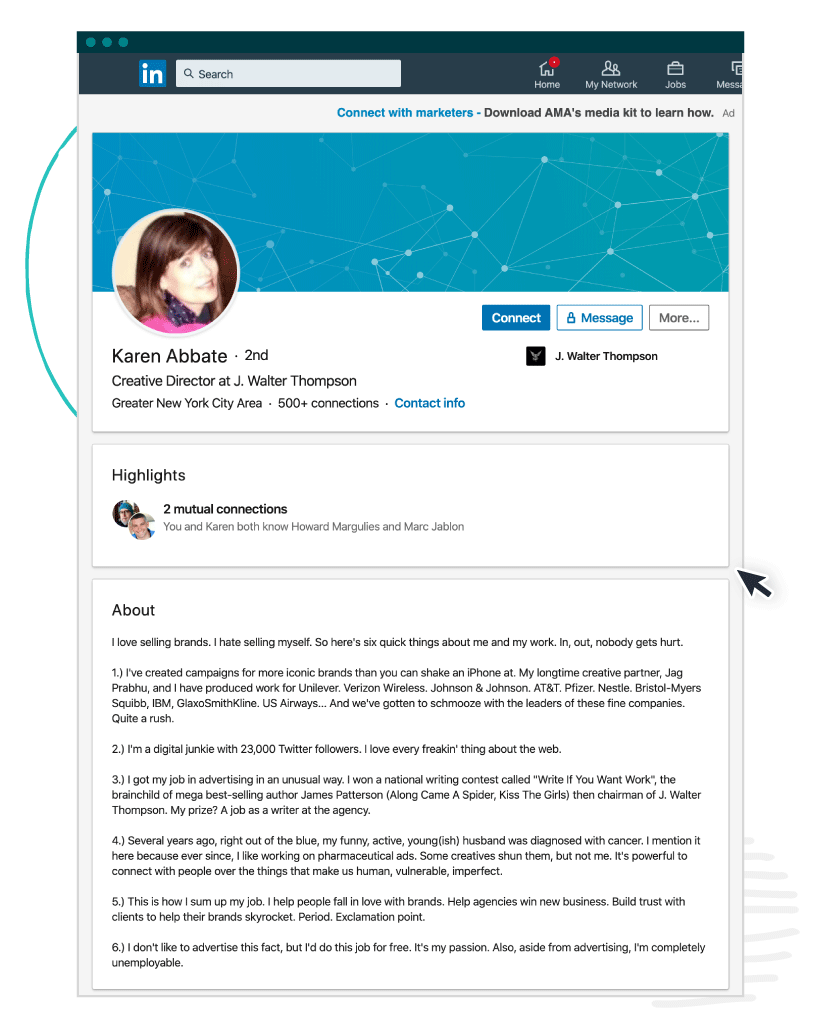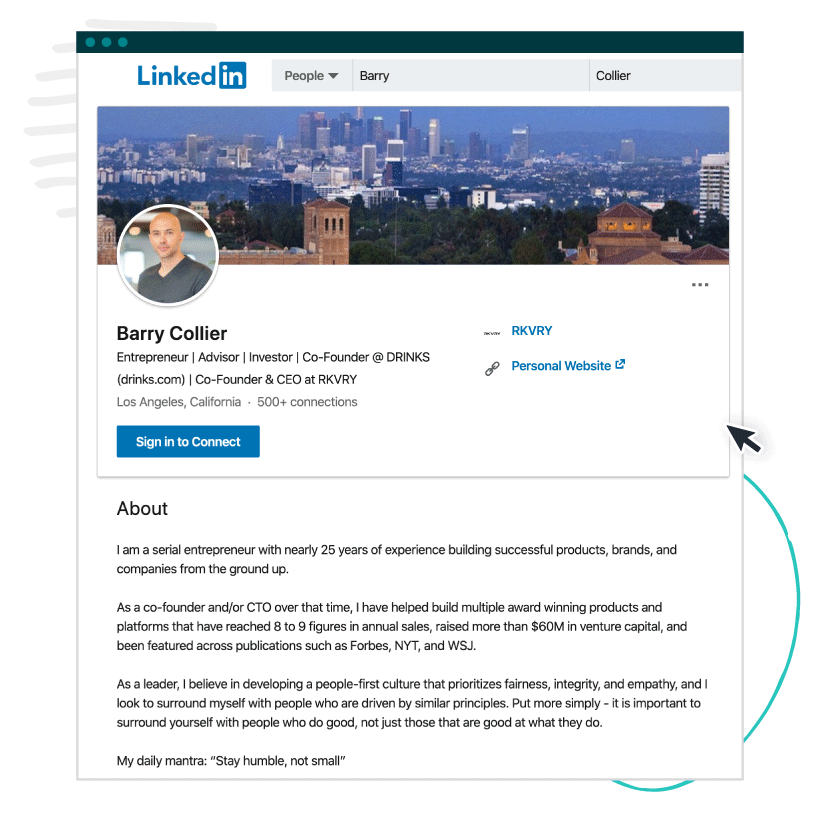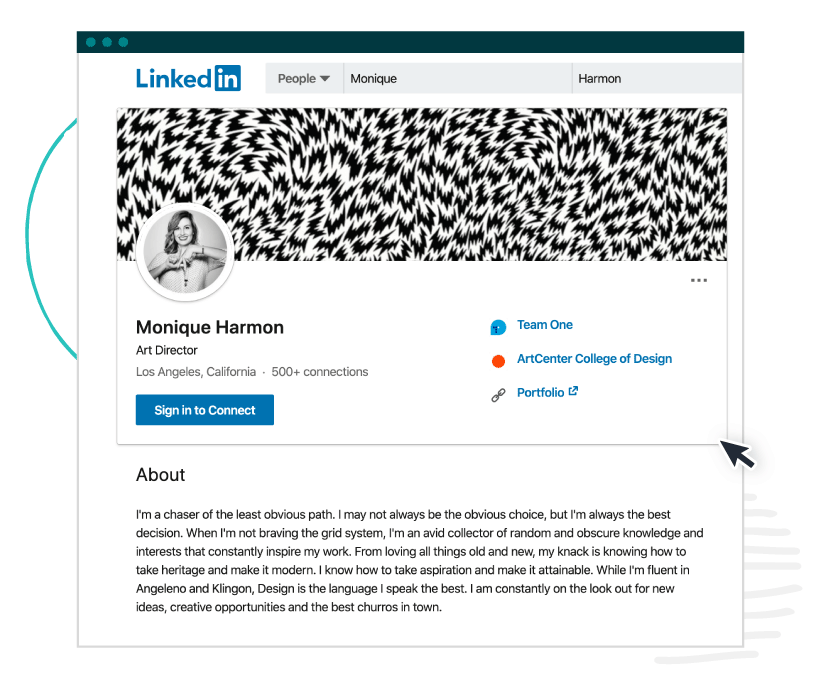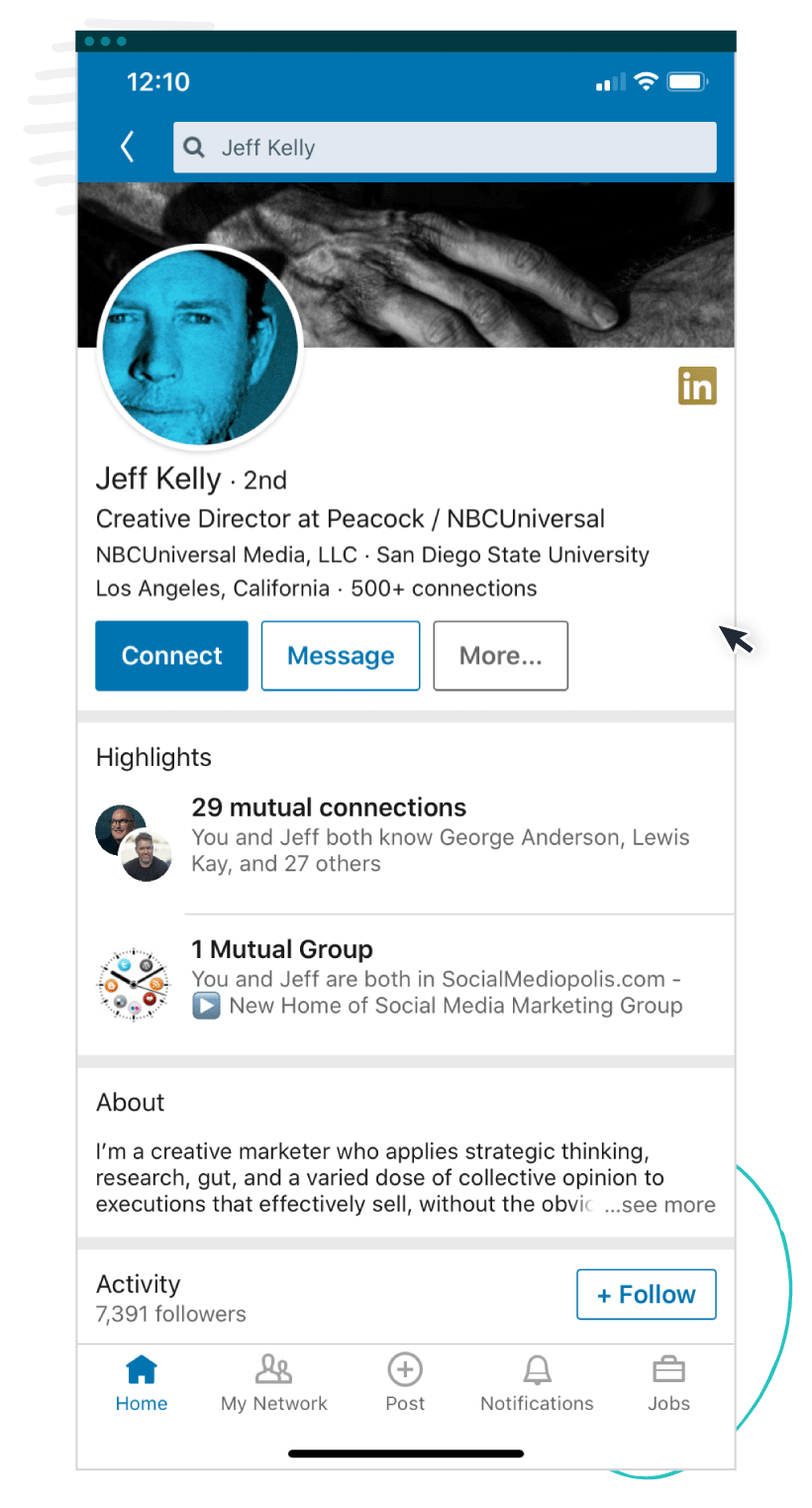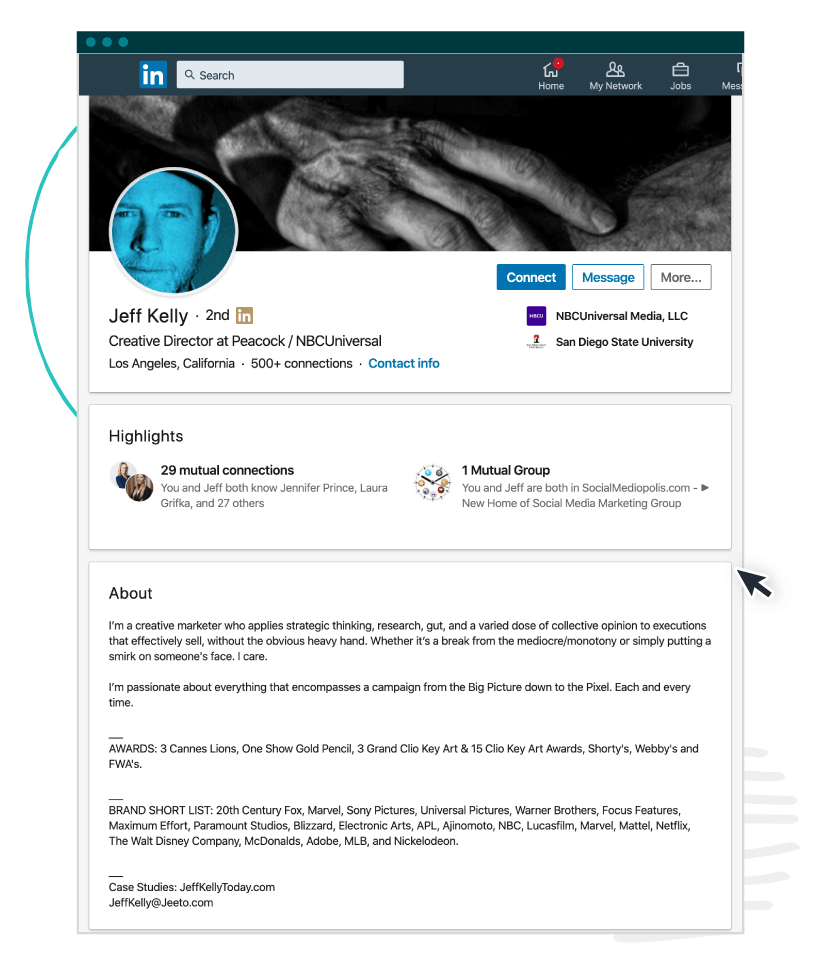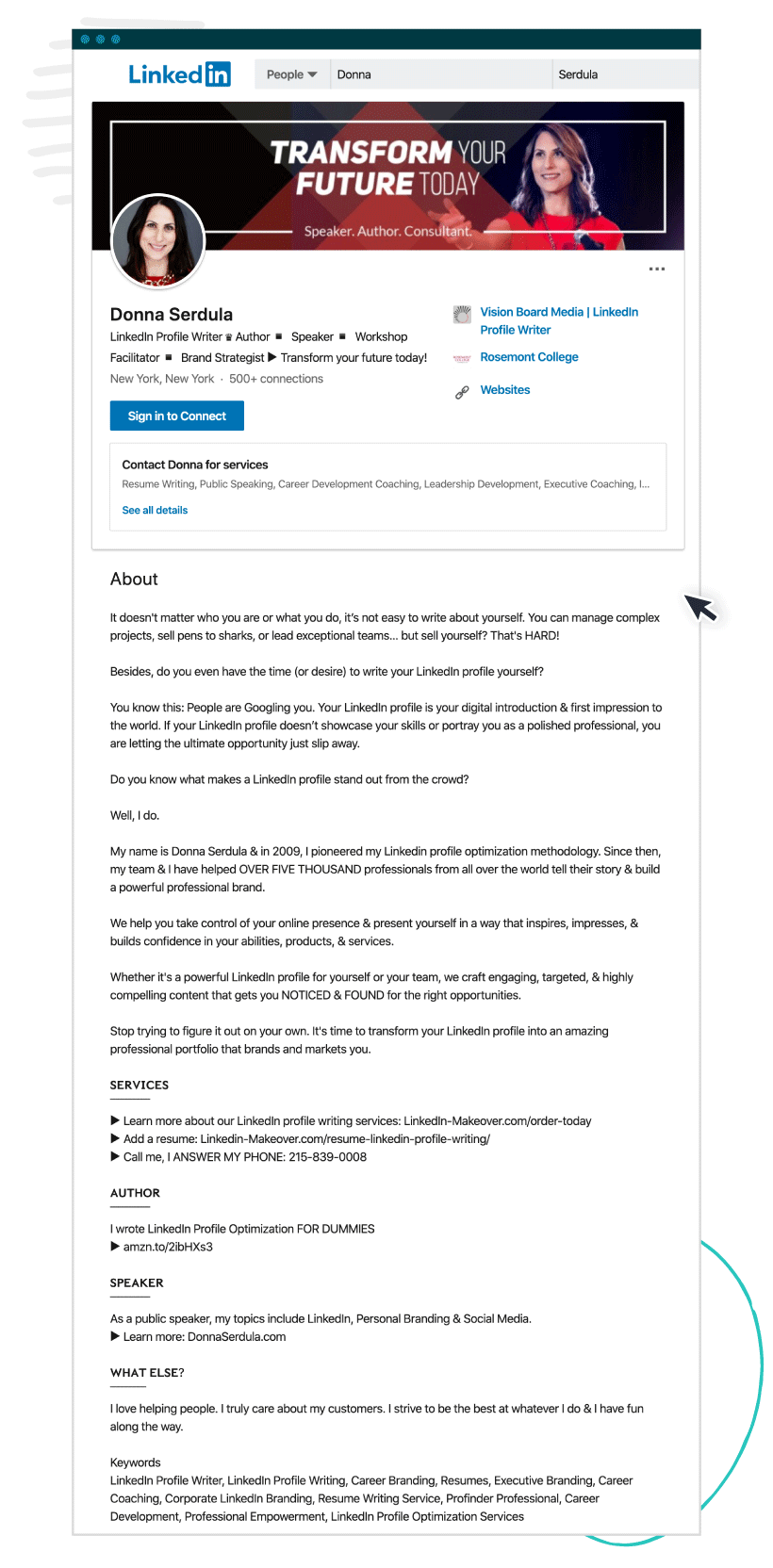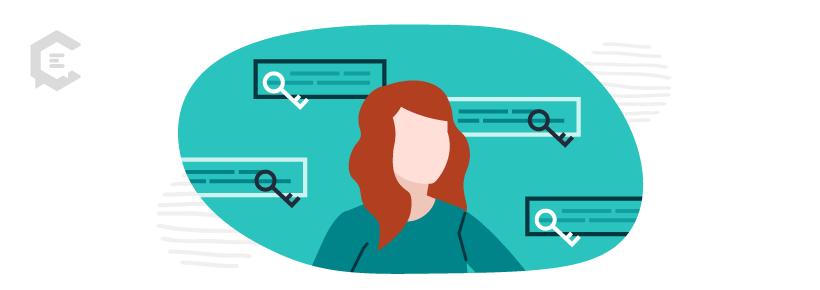Your LinkedIn summary — or the “About” section — might be the most important part of your LinkedIn profile. Why? Because it’s the first impression where you can blow people away with a captivating career snapshot — or turn them off.
Unfortunately, most people on the platform aren’t taking full advantage. It’s time to make the most of yours — have a look at how to write a LinkedIn summary based on expert advice.
If you’re a typical freelancer or creative marketer, learning how to write a LinkedIn summary is one of those painful things you put off as long as possible — like car shopping, trips to the dentist, or splinter prying.
However, if you’re serious about your career and how to advance it, it’s an absolute must — since LinkedIn is the No. 1 social network for professionals, with over 830 million members worldwide. Some treat it like nothing more than an online resume; others use it as a networking platform, and some do both.
But here’s the thing: Your summary shouldn’t be an afterthought. Rather, it’s an opportunity to shape your story and how you’re perceived. The words you put in the 2,600-character (max) allotted space make a difference. You know your career better than anyone — that’s why understanding how to encapsulate that story succinctly and effectively with a professional, punchy, power-packed paragraph is essential… and why it never hurts to have a little help.
3 Things to Do Before You Write Your LinkedIn Summary
With the help of Donna Serdula, founder of LinkedIn-Makeover.com and author of ‘LinkedIn Profile Optimization for Dummies,’ there’s much to know in terms of best practices and what works effectively in terms of style, selling points, and substance.
As an overarching strategy, Serdula says, “The LinkedIn summary should be a digital introduction, a first impression. It really should summarize your reputation, who you are, what you do, and why it matters to people.”
The best summaries will ingratiate you to clients, cement your brand, and inspire smiles and follow-ups. The bad ones can trigger apathy, lack of confidence, and even hard passes. Given the increased usage and reliance on LinkedIn for industry professionals, it can’t be overstated how important it is to make the best possible use of the summary space.
Before you learn how to write a LinkedIn summary that lands you your dream client or networking opportunity, Serdula suggests you complete the following three action items:
1. Figure out why you’re on LinkedIn: What are you trying to accomplish? Are you on LinkedIn to get more work? For reputation management? Or sales and prospecting?
2. Think about your target audience: What do they need to know about you? What do they want to learn about you? What is important to them?
3. Decide if you want to be found on LinkedIn for an opportunity: If someone’s typing in a keyword, do you want to pop up in that search? For a lot of people, the answer is “yes.” But for some people, it’s “no.”
5 LinkedIn Summary Examples That Show You How to Stand Out
1. Show your experience, yes… but couch it in personality
Why this LinkedIn summary example works:
- Overall, Karen strikes a great balance between saying things that win confidence in her creative abilities — and writing conversationally, drenching her personality experience without appearing boastful or overly self-serving.
- We love Karen’s first 23 words — her lead sentence hooks you from the get-go with a fun/revealing (if not mildly self-deprecating) opener. Especially the first eight: “I love selling brands. I hate selling myself.” Those say a lot about someone.
- She demonstrates humor with the final line, “Also, aside from advertising, I’m completely unemployable.” Not only is that endearing, but it also speaks to her overall expertise and love of the advertising game. Passion is important!
Expert tip: As Serdula explains, one’s presence on LinkedIn is “more than just a calling card. It’s who you are, virtually… your online persona.” Along those lines, Karen gives you a strong sense of who she is — skill-wise and sentimentally — filling the space with a well-articulated and strategic snapshot of her career.
It’s a compelling case for being remembered. In addition, Karen’s approachable nature would also seem to jell well with Serdula’s expert advice about writing summaries with feeling. “That’s what you’re aiming for: That real human “About” section. It has a heart and soul and should grab people.”
2. Tell people not just who you are but what you stand for…
Why this LinkedIn summary example works:
Barry knows how to write a LinkedIn summary that gets attention for three standout reasons:
1. He hits you with an impressive encapsulation of who he is from the start — dropping a range of keywords from “serial entrepreneur” to “25 years’ experience,” which speaks volumes not just to readers but to the LinkedIn search algorithm.
2. Barry backs it up with data — delivering specific numbers around the annual sales for the products he’s built, venture capital funds he’s helped raise, and even makes a mention of the range of publications he’s been featured in (Forbes, NYT, and WSJ).
3. What impresses us the most about Barry’s approach, however, is how he addresses his character at the end, what he believes in, and his preferences for work culture as a person in a position to hire:
As a leader, I believe in developing a people-first culture that prioritizes fairness, integrity, and empathy, and I look to surround myself with people who are driven by similar principles. Put more simply — it is important to surround yourself with people who do good, not just those that are good at what they do. My daily mantra: “Stay humble, not small.”
Expert tip: To the first point, Serdula offers sound advice regarding keywords and how you should use them to be successfully found in a LinkedIn or Google search. “You want to figure out: What would those words be? Then, make sure you’re infusing those keywords throughout your LinkedIn profile. I’m not talking with obnoxious repetition… but organically into your narrative.”
3. Don’t be afraid to leave white space
Why this LinkedIn summary example works:
- Like any good art director, Monique is not afraid to leave white space — keeping it relatively short and sweet but making good use of the words she chooses to write.
- Monique manages to sound interesting without being too obscure. “I may not always be the obvious choice, but I’m the best decision” is an intriguing line that begs people to want to learn why.
- By saying she’s “constantly on the lookout for new ideas, creative opportunities,” she’s signaling to her audience that she’s open to making new connections. Making that fact known is a matter of personal preference, but if you’re looking for work, it can signal to your network (and beyond) that they should keep you in mind should something come up.
Expert tip: Another thing Monique does well here (as did the first two) is talking directly to the reader. As Serdula says, “When you write your ‘About’ section, do it in the first-person narrative as opposed to the third person (which can seem very distant).”
This will not just help you make a connection but will make you seem accessible and approachable. Both qualities draw people in!
4. Make the first 2–3 lines count
Why this LinkedIn summary example works:
- LinkedIn shows only 2-3 lines of your summary (roughly 300 characters) before readers must click “see more” if they want to keep reading. Jeff makes great use of the first 280 characters, listing a slew of positive traits (not jobs) that speak to who he is — his concern for quality control, being success-driven, and thinking strategically, amongst other things.
- His headline speaks to his current job title and position with a known brand (“Creative Director at Peacock / NBC Universal”), so after his opening plea, Jeff then offers up his awards won and brands he’s worked with. With lots of notable names and accolades on this list, it behooves him to elevate some of his more impressive experiences to the top.
Expert tip: Don’t get bogged down in some sort of “wait for it” moment to start your LinkedIn summary. Leading with a compelling and/or revealing statement about you is huge — because that’s all people might see. If you don’t believe me, look at the mobile screenshot below of Jeff’s summary to see how little is actually shown before it requires an action to see more.
5. Serve it up in a digestible fashion
Why Donna’s LinkedIn summary example works:
- Think about how people read these days. We like quick hits, sound bites, and digestible morsels. In this regard, Donna lets the content breathe like a fine wine as the eye moves down the page, delivering information in an easily scannable fashion.
- She also uses Unicode (graphics, different font styles, etc.) to give the page more visual intrigue. Given the amount of information she chooses to present to convey what her service does, these images make her summary look different.
- Other than the fact that it’s written by someone who’s literally written the book on how to optimize your LinkedIn profile, Donna makes sure her readers know where they can contact her, buy her book, and sign up for a LinkedIn makeover.
Expert tip: To the last point about making sure people know how to contact you, Serdula says, “Opportunity can’t knock if it doesn’t know which door to knock on.” In addition, Serdula reveals the pros and cons of using Unicode on the summary page:
More and more people have been using unicode on their LinkedIn profile to make it seem as if the text is formatted since there are no bullets, bold, or italics on LinkedIn. But if you look around, especially at my profile, you will see that there are certain words that are bulleted to show a list… It looks pretty, but one, screen readers can’t read it, so if a person who is visually impaired is visiting your profile, their screen reader will not work for them… and two, you’re losing search. All that great content isn’t being indexed by LinkedIn. If you do attempt to format [with unicode], just do it sparingly. Maybe just with a header or a call-to-action.
As for Serdula’s approach to breaking up the content in her “About” section, she is a proponent of breaking up the bulky stuff. “When you’re faced with a huge block of text, it doesn’t matter how well written it is. You just can’t penetrate it.” A quick solution, according to Serdula? “Make sure to hit the return button every now and then…” Your reader will appreciate it.
5 LinkedIn Summary Examples That Show You What NOT to Do
[Note: The examples created below are inspired by real LinkedIn summary examples that contained these actual faux pas.]
1. Don’t recite your resume
My first job out of college was at Pinkberry where I worked for two years until I went to Chase Bank for three… That’s when the insurance world called, where I worked for Geico, Progressive and now State Farm, where I sell auto and life. Btw, interested??
If you want to know how not to write a LinkedIn summary, the above example is a great one. Merely listing accomplishments without any context as to how they’ve helped shape who you are in your career is a LinkedIn no-no. There’s an entire section devoted to work “Experience” on LinkedIn, so save your breath here… and add more breadth there.
Instead, use the space for a compelling, 360-degree snapshot of who you are, what you’ve done, and what makes you awesome. Your previous roles should be woven into your story contextually. It’s not a place to list the things they’re gonna see anyway when (and if) they scroll down. Which, as luck would have it, they probably won’t since you’ve attempted to say it all right here.
2. Along those lines, don’t copy/paste from your resume
Even more of a no-no for the platform? Copying and pasting your resume into the summary section.
Example:
STATE FARM INSURANCE – Los Angeles, CA
Customer Service Specialist – October 2018 – Present
– Answer and direct 40+ calls daily, with goals including selling plans, responding to service queries.
– Trained 5 employees in customer service software, as well as in basic duties.
– Received a 90% average customer satisfaction rating, winning “Employee of the Month” in July of 2019
The copy/paste-from-the-resume move may seem like a good one if you’re at a loss for time and things to say in this space. But don’t. Even your good neighbor Jake from State Farm would highly disapprove.
As Serdula states, “When you copy and paste a resume, that’s one of the biggest faux pas. Even if you’re looking for a job, you should not be pasting a resume. These are two totally different things… they should complement each other.”
Instead, fuse your accomplishments into an engaging narrative. What is it you love about customer service? Is it your outgoing nature? Or that you thrive on human connection? Add some emotion… show there’s a person behind the accomplishments.
3. Don’t confuse your LinkedIn summary with your unabridged biography
I was born to a family of five, in a poor section of the Bronx. My mother never took to breastfeeding, so I was a bottle baby from the start, undersized, underfed, and underwhelming. As the middle child, I had a minor birth defect — a mole above my right eye that screamed ‘everyone, please keep away.’ But now I just write seemingly unending LinkedIn summaries to handle that for me.
We think you get the point. What you choose to write should have contextual relevance to the career you’re trying to promote.
Here’s what this oversharing LinkedIn summary does:
- It wastes prime real estate — the first 300 characters — talking about something that won’t get you a job and has little-to-no information about your work experience, career, or expertise.
- It also says you don’t really know how to use the platform, which can work against you in several ways.
This kind of chance-taker *might* endear you to a specific audience if you’re a novelist or stand-up comic. But more likely than not, it will cause the reader to click away and wonder what your mole has to do with being a coder.
Think about the “About” section as an opportunity to substantiate why you’re the person for the job, any job, with present-day jargon and relevant nuggets about your work experience. You don’t have much time or space, so better make the most of it.
Tell the greatest possible story in the shortest amount of words possible — that’s your goal in life… and LinkedIn.
4. Don’t talk about yourself in the third person
Carl Spackler is a detailed-oriented groundskeeper at Bushwood Country Club, who stays dedicated to manicuring the greens and believes in making true one-on-one connections with the people he speaks to. Not only does he specialize in the art of intimate portrayals, but in his spare time, he also prevents gophers from disrupting the golf games of people in plaid pants.
You’ve seen it, you may have even done it: Referring to yourself in the third person. It’s a common method people use to write their bios and when they want to seem more professional. Here’s the thing: Everyone knows you wrote your LinkedIn summary.
So spare them any confusion by referring to yourself as some third-party entity. Knowing how to write a LinkedIn summary that grabs attention starts with a meaningful and memorable human connection.
5. Don’t overdo the keywords
Accomplished technology professional who can lead business development, software design and contract management efforts. I’m also a customer-success driven sales executive with experience in enterprise data management solutions, cloud (IaaS, PaaS, SaaS), and product management. My other specialties include: engineering, security, analytics and putting people to sleep.
It’s great that you can do all these things, really. And they will all come in handy when you get that job (or client) you’re looking for. But don’t use your LinkedIn summary section simply to list them all out. At least, not at the top. Do it in the skills section instead.
The last thing you want to do is kill interest by reciting all your amazing qualities in one burst. It kind of kills the mood. Also, you’re not separating yourself from presumably hundreds of others who also do these things in your market. Put thought into how you represent yourself that actually says something about you in a creative way, not just in list-based fashion.
As Serdula notes, “If you’re just trying to game the system with your LinkedIn summary, it’s obnoxious and turns people off. So, you’ve gotta write to AI and to the human eye. When you just repeat the keywords, you’re only writing to AI… you want to find a nice balance.”
Telling a story about who you are, with substance, style, and the occasional keyword, is going to be your most powerful way to go about this. If you try to shoehorn all the words you think will catch the eye of an algorithm, you’re truly missing the point.
A Note About Buzzwords in Your LinkedIn Summary
Like keywords, don’t try to sound super-relevant by cramming as many buzzwords as possible into your summary section.
Here are a few overused buzzwords to avoid (or use sparingly):
- Professional
- Dynamic
- Specialized
- Focused
- Strategic
- Passionate
- Successful
- Expert
- Team player
“Another faux pas is using tired cliches such as ‘out-of-the-box thinker,'” says Serdula with a smile. “As soon as I see ‘out-of-the-box’ thinkers, I know they’re not out-of-the-box.”
How to Write a LinkedIn Summary That Gets Your Desired Result
Remember, your LinkedIn summary is only one piece of your profile puzzle (in addition to your headline, skills, recommendations, and activity). But it’s an important piece, a way to control the message with originality, substance, and authenticity; you let people know who you are despite what might be happening with things outside your control, like a company’s online reputation.
As Serdula concludes, “For most people when a name search is conducted [via Google], that LinkedIn profile is one of the first results… and people are looking. You have the ability to control and shape their perspective.”

